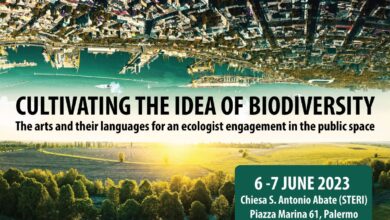Book Releases – “Applying Aesthetics to Everyday Life: Methodologies, History, and New Directions” & “Urban Aesthetics: Atmospheres and the Artification of Spaces”

We’re thrilled to share the exciting news that the book “Applying Aesthetics to Everyday Life: Methodologies, History, and New Directions” co-edited by Lisa Giombini and Adrian Kvokacka, is now ready for order!

Featuring 14 insightful chapters, the book delves into a diverse range of approaches to Everyday Aesthetics – “from stones to storms, encompassing house chores, social behavior, popular culture, and design objects” (from Arto Haapala’s review). We believe these chapters vividly portray the potential of the transformative ‘everyday turn’.
A big shoutout and gratitude to all our authors: Katya Mandoki, Thomas Leddy, Max Ryynänen, Arnold Berleant, Gioia Laura Iannilli, Adam Andrzejewski, Sanna Lehtinen, Brit Strandhagen, Matti Tainio, Zoltán Somhegyi, Madalina Diaconu, Wolfgang Welsch, Elisabetta Di Stefano, and Yuriko Saito! Their contributions have made this journey so enriching.
Applying Aesthetics to Everyday Life surveys current debates in the field of everyday aesthetics, examining its history, methodology and intersections with cognate research areas. Lisa Giombini and Adrián Kvokacka bring together an international team of renowned scholars who are shaping the present and future of the discipline.
They demonstrate how the historical origins of everyday aesthetics emerges across the history of Western aesthetic thought, from Renaissance thinkers to the modern German philosophers Baumgarten, Kant and Heidegger. Chapters shed light on the field’s methodological underpinnings, tracing its theoretical foundations back to epistemology and ethics and assess the potential of everyday aesthetics as a theoretical tool. They reveal its interdisciplinary nature and how it assists various fields of inquiry, including environmental and urban aesthetics, conservation ethics and the philosophy of art.
Through fresh explorations of its origins, background and contemporary developments, this collection advances a new definition of everyday aesthetics and provides a cutting edge reflection on the world we inhabit today.
Table of Contents
List of Figures
Introduction: Rethinking Roots, Imagining Futures, Lisa Giombini (Roma Tre University, Italy) and Adrián Kvokacka (Presov University, Slovakia)
Part I: Foundations
1. Prosaics: Theory of Everyday Sensitivity as Baumgarten’s Aesthetica Practica, Katya Mandoki (Universidad Autónoma Metropolitana, México)
2. Kant and the Place of Everyday Aesthetics in the Critique of Judgement, Adrián Kvokacka (Presov University, Slovakia)
3. Heidegger’s ‘The Origin of the Work of Art’ and the Extra-ordinary in Everyday Aesthetics, Thomas Leddy (San Jose State University, USA)
4. The Aesthetics of Popular Culture as Everyday Aesthetics: Historical and Contemporary Perspectives, Max Ryynänen (Aalto University, Finland)
5. Whose Everyday? On the Cultural Aesthetics of Everyday Life, Arnold Berleant (Long Island University, USA)
6. Can we Design Familiarity?, Gioia Laura Iannilli (Alma Mater University of Bologna, Italy)
7. Predictability, Improvisation and the Everyday, Adam Andrzejewski (Warsaw University, Poland)
Part II: Applications
8. Rethinking the Urban Sublime, Sanna Lehtinen (Aalto University, Finland), Brit Strandhagen (NTNU, Norway) and Matti Tainio (University of Lapland, Finland)
9. The Use and Usefulness of Unused Spaces: Neglected urban environment in changing perspectives, Zoltán György Somhegyi (Károli Gáspár University of the Reformed Church, Hungary)
10. Tornadoes and the Poietics of Nature, Madalina Diaconu
11. Stones – Our Distant Cousins, Wolfgang Welsch (Universität Jena, Germany)
12. Aesthetics of Behaviour, Elisabetta Di Stefano (University of Palermo, Italy)
13. Aesthetics of Doing House Chores: Working in and with the World, Yuriko Saito (Rhode Island School of Design, USA)
14. Care in Conservation Ethics, Lisa Giombini (Roma Tre University, Italy)
We are also thrilled to announce the publication of a new book that opens up new horizons in the field of Everyday Aesthetics: “Urban Aesthetics: Atmospheres and the Artification of Spaces” (Milan, Mimesis, 2023) by Elisabetta Di Stefano. Buy now!
This volume explores urban aesthetics through two interpretive paradigms: the concepts of atmosphere and artification. The notion of “atmosphere” is applied to aesthetics by the philosopher Gernot Böhme, who considers it a privileged paradigm for investigating emotional spaces, understood as the result of affective relationships between the perceiving subject and the perceived object. Therefore, the aesthetics of atmospheres proves to be a useful theoretical tool for architectural and urban design. The atmospheres of private and public environments are analyzed through case studies focused on domestic spaces, the space of books (libraries and bookstores), and sacred spaces. These analyses often move between real and imaginary spaces, as according to Boehme, the aesthetics of atmospheres has a rhetorical matrix and finds an exemplary case in literary descriptions.
In urban aesthetics, the concept of atmosphere is productively related to that of artification, which in a broad sense, indicates “the transformation of something that is not art into art.” By interweaving various concepts of artification (those of the French sociologists Natalie Heinich and Roberta Shapiro; that elaborated by the theorists of Everyday Aesthetics Thomas Leddy, Yuriko Saito, Ossi Naukkarinen, and that of the ethologist Ellen Dissanayke), artification is here understood as a process and a “making of art” in a collective sense. This “making art together” often results in not only modifying the environments that are “artificated” but also the individuals involved in the transformative process. Therefore, artification takes on the value of a tool for social and urban transformation. This phenomenon is analyzed through some examples centered on collective artistic processes carried out in private homes during lockdowns, in prisons, and in degraded urban peripheries that are increasingly decorated with murals. However, in the various examples considered, the transformation does not translate into a process aimed solely at producing works of art or purely external embellishment, but into a collective “making of art” that brings about social changes.






